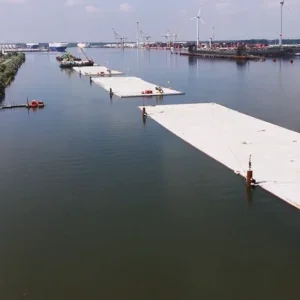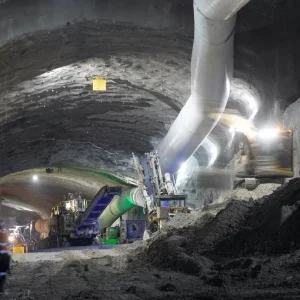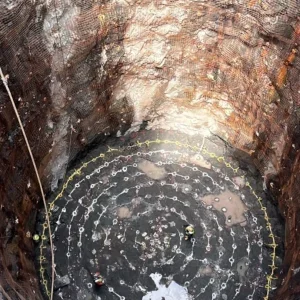Construction of the 4.5km long twin-track Schulwald Tunnel, the longest tunnel on the 219km high-speed railway line being built between Cologne and Frankfurt, is on schedule for a September breakthrough in the northern part of the tunnel and a December breakthrough in the southern. The tunnel is being excavated from three locations by top heading and bench. Bench excavation will start as soon as the top heading is finished.
This tunnel forms part of a 12km stretch of the new line under construction by the ATAC JV consisting of Alpine; Ilbau; Beton und Monierbau; Östu Stettin; Hinteregger & Söhne; and Thyssen Schachtbau. Client is the German Federal Railway (Deutsche Bahn). The construction period is 1997 to 2001.
The tunnel has an excavated cross section of 165m², a lined cross section of 90m² and an incline of 4%. The rock (phyllite) is soft, and rock support plays an important role in the excavation. Excavators are used first to dig out a 4.4m wide and 6.5m high pilot heading, 30m ahead of the two side drifts. Blasting is needed in harder rock.
The roof and sides of the top heading are secured with spiling. Every 1m, immediate support is achieved by installing wire mesh and lattice girders in the roof and applying shotcrete. After a final layer of wire mesh and shotcrete has been applied, rockbolts are installed. In poor ground, the face is also supported by up to 16 x 12m bolts. Tunnel advance of 12m/day is being achieved.
Four Atlas Copco Rocket Boomer 352S-1838 2-boom rigs are used for rock support measures. A penetra-tion rate of 4-5 m/min is achieved. Air flushing is used to clean the holes.
To protect the tunnel from water inflow, wells are drilled 10-15m from the tunnel. They are 60-70m deep and are used to lower the water table. Final lining is due to start in spring 2000, when the water table will be returned to normal.







